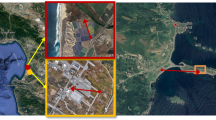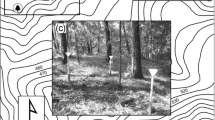Abstract
An observational study has been conducted concerning atmospheric dewfall and fog-droplet deposition with application to the formation and maintenance of fog layers. The relationship between dew and fog is discussed together with the challenges and requirements to measure representative values of their deposition to the surface. A practical instrument developed at the UK Met Office Research Unit, Cardington, is described. The instrument is a small portable device that uses a load cell to measure the weight of a pan upon which various types of natural and artificial canopies can be placed, and can measure dewfall and fog-droplet deposition to an accuracy of 0.0005 mm. Dewfall results from this device are shown for a selection of nights under varying conditions. On a given night the overriding factor determining the amount of dew deposition appears to be location. Several dewmeter devices were placed at different locations around the 18 ha Cardington field site for various clear nights and it was found that dew amounts varied significantly, depending on location: canopies with a more open aspect experienced more deposition by up to a factor of two. The results also suggest that the hygroscopic effect of a canopy, whereby water is absorbed into the canopy and topsoil layer before dew formation begins, is also important for the removal of atmospheric water vapour. Results indicate this effect can be of a similar magnitude to dew deposition. Measurements of fog-droplet deposition showed total water deposition rates did not change when thin radiation fog formed. When optically thick adiabatic fog formed, deposition rates were seen to decrease with time or be generally lower than for thinner radiation fog. Further observations are required to establish if the behaviours found are typical for all fogs.













Similar content being viewed by others
References
Beswick KM, Hargreaves KJ, Gallagher MW, Choularton TW, Fowler D (1991) Size-resolved measurements of cloud droplet deposition velocity to a forest canopy using an eddy correlation technique. Q J R Meteorol Soc 117:623–645
Beysens D, Muselli M, Nikolayev V, Narhe R, Milimouk I (2005) Measurement and modelling of dew in island, coastal and alpine areas. Atmos Res 73:1–22
Best MJ, Pryor M, Clark DB, Rooney GG, Essery RLH, M’enard CB, Edwards JM, Hendry MA, Porson A, Gedney N, Mercado LM, Sitch S, Blyth E, Boucher O, Cox PM, Grimmond CSB, Harding RJ (2011) The joint UK land environment simulator (JULES) model description—part 1: energy and water fluxes. Geosci Model Dev 4:677–699
Brown R, Roach WT (1976) The physics of radiation fog: II. A numerical study. Q J R Meteorol Soc 102:335–354
Dollard GJ, Unsworth MH (1983) Field measurements of turbulent fluxes of wind-driven fog drops to a grass surface. Atmos Environ 17:775–780
Duynkerke PG (1999) Turbulence radiation and fog in Dutch stable boundary layers. Boundary-Layer Meteorol 90:447–477
Fahey BD, Murray DL, Jackson RM (1996) Detecting fog deposition to tussock by lysymetry at Swampy Summit near Dunedin, New Zealand. J Hydrol (NZ) 35:85–102
Fowler D, Morse AP, Gallagher MW, Choularton TW (1990) Measurements of cloud water deposition on vegetation using a lysymeter and a flux gradient technique. Tellus 42B:285–293
Fuzzi S, Orsi G, Mariotto M (1985) Wet deposition due to fog in the Po Valley, Italy. J Atmos Chem 3:289–296
Gallagher MW, Beswick K, Choularton TW, Coe H, Fowler D, Hargreaves K (1992) Measurements and modelling of cloudwater deposition to moorland and forests. Environ Pollut 75:97–107
Garratt JR, Segal M (1988) On the contribution of atmospheric moisture to dew formation. Boundary-Layer Meteorol 45:209–236
Gultepe I, Tardif R, Michaelides SC, Cermak J, Bott A, Bendix J, Muller MD, Pagowski M, Hansen B, Ellrod G, Jacobs W, Toth G, Cober SG (2007) Fog Research: a review of past achievements and future perspectives. Pure Appl Geophys 164:1121–1159
Heusinkveld BG, Berkowicz SM, Jacobs AFG, Holtslag AAM, Hillen WCAM (2006) An automated microlysimeter to study dew formation and evaporation in arid and semiarid regions. J Hydrometeorol 7:825–832
Holwerda F, Burkard R, Eugster W, Scatena FN, Meesters AGCA, Bruijnzeel LA (2006) Estimating fog deposition at a Puerto Rican elfin cloud forest site: comparison of the water budget and eddy covariance methods. Hydrol Process 20:2669–2692
Jing Z, Yuan-ming Z, Downing A, Jun-hui C, Xiao-bing Z, Bing-chang Z (2009) The influence of biological soil crusts on dew deposition in Gurbantunggut Desert, Northwestern China. J Hydrol 379:220–28
Kaimal JC, Finnigan JJ (1994) Atmospheric boundary-layer flows: their structure and measurement. Oxford University Press, New York, 289 pp
Kaseke KF, Mills AJ, Brown R, Esler KJ, Henschel JR, Seely MK (2012) A method for direct assessment of the ‘non rainfall’ atmospheric water cycle: input and evaporation from the soil. Pure Appl Geophys 169:847–857
Kidron GJ (1999) Altitude dependent dew and fog in the Negev Desert, Israel. Agric For Meteorol 96:1–8
Luo W, Goudriaan J (2000) Dew formation on rice under varying durations of nocturnal radiative loss. Agric For Meteorol 104:303–313
Malek E, McCurdy G, Giles B (1999) Dew contribution to the annual water balances in semi-arid desert valleys. J Arid Environ 42:71–80
Moro MJ, Were A, Villagarcia L, Canton Y, Domingo F (2007) Dew measurement by eddy covariance and wetness sensor in a semiarid ecosystem of SE Spain. J Hydrol 335:295–302
Ninari N, Berliner PR (2002) The role of dew in the water and heat balance of bare loess soil in the Negev Desert: quantifying the actual dew deposition on the soil surface. Atmos Res 64:323–334
Porson A, Price JD, Lock A, Clark P (2011) Radiation fog part II: large-eddy simulations in very stable conditions. Boundary-Layer Meteorol 139:193–224
Price J (2011) Radiation fog part I: observations of stability and drop size distributions. Boundary-Layer Meteorol 139:167–191
Roach WT, Brown R, Caughey SJ, Garland JA, Readings CJ (1976) The physics of radiation fog: I—a field study. Q J R Meteorol Soc 102:313–333
Rodhe B (1962) The effect of turbulence on fog formation. Tellus 14:49–86
Schemenauer RS (2009) Fog harvesting, pp 41–46. In: Cech TV (ed) Principles of water resources, history, development, management, and policy, 3rd edn. Wiley, New York, 546 pp
Verhoef A, Diaz-Espejo A, Knight JR, Villagarcia L, Fernandez JE (2006) Adsorption of water vapour by bare soil in an olive grove in Southern Spain. J Hydrometeorol 7:1011–1027
Vermeulen AT, Wyers GP, Romer FG, Van Leeuwen NFM, Draaijers GPJ, Erisman JW (1997) Fog deposition on a coniferous forest in The Netherlands. Atmos Environ 3:375–386
Whiteman CD, De Wekker SFJ, Haiden T (2007) Effect of dewfall and frostfall on nighttime cooling in a small, closed basin. J Appl Meteorol Climatol 46:3–13
Acknowledgments
Staff at the Met Office field site, Cardington, are acknowledged for their support in undertaking this work, as are the reviewers and Editor for their helpful comments.
Author information
Authors and Affiliations
Corresponding author
Appendix 1
Appendix 1
This section discusses the calculation of canopy longwave emissivity. This is measured using an aluminium cone with a polished inner face (and thus very low emissivity of \(\approx \)0.03). The narrow end of the cone has a small aperture and mounting for a Heitronics KT19.85 II infra-red thermometer (IRT, 9.6–11.5 \(\upmu \)m wavelength sensitivity). The wide aperture is open and is placed over the canopy of interest and the IRT measures the radiance emitted. The IRT assumes an emissivity of 1 and returns calculated temperature. Placing this cone over a surface with high emissivity (0.95 or more) gives the surface an effective emissivity of close to 1 (J Taylor, Met Office, personal communication, 2010). The black-body emissivity is then calculated using Planck’s law,
where \(B_{\lambda }\) is the emitted radiance at temperature \(T\), and \(h,c,k,\lambda \) are the Planck function, speed of light, Boltzmann constant and wavelength of light under consideration respectively. For an object emitting and reflecting radiation at a wavelength, \(\lambda \), we have,
The first term on the right-hand side is the emitted radiation from the canopy and the second term is the reflected component; \(\varepsilon \) is the emissivity. In practice, \(T_\mathrm{o}\) and \(T_\mathrm{r}\) are the canopy skin and sky temperatures respectively. Therefore the IRT may be used with the aluminium cone to measure \(T_\mathrm{o}\) and the radiance in the first term of Eq. 6 estimated using Eq. 5. \(R_\mathrm{m}\) is measured by removing the IRT from the cone and measuring the canopy temperature from a height of approximately 500–600 mm, then using Eq. 5. Finally, the sky radiance is estimated by pointing the IRT at the sky, measuring \(T_\mathrm{r}\), and using Eq. 5 to estimate the radiance for the second term in Eq. 6; Eq. 6 can then be solved for the emissivity. Whilst making these measurements, it became apparent that atmospheric conditions were critical to the success of the calculation. Strong sunlight, any wind, or variable cloud cover usually resulted in poor calculations (standard deviations calculated for \(\varepsilon \) were very large with values of \(\varepsilon > 1\)). However, measurements made at dawn under low light, no wind and clear sky were found to produce acceptable results.
The emissivity calculated from an infra-red device may be corrected in the following way. Firstly, the measured radiance \(R_\mathrm{m}\) is determined using Eq. 5, then \(B_{\lambda T_\mathrm{o}}\) is calculated using Eq. 6 with known emissivity. In this instance, the sky radiance is not known, but may be estimated based on a sky temperature of \(-\)60 \(^{\circ }\)C. (This was a typical measured value during some of the clear-night trials.)
Given the second term in Eq. 6 is small, and \(\varepsilon \) near 1 in most instances, this only introduces a small error. For the RSDD canopy, and using the data shown in Fig. 9, altering sky temperature by \(\pm \)20 \(^{\circ }\)C from the value used above yields an average change in calculated temperature of 0.16 \(^{\circ }\)C. In practice, the radiometer accuracy of \(\approx \)1 \(^{\circ }\)C is the greater error. Finally, the correct temperature may be calculated by re-arranging Eq. 5,
Rights and permissions
About this article
Cite this article
Price, J.D., Clark, R. On the Measurement of Dewfall and Fog-Droplet Deposition. Boundary-Layer Meteorol 152, 367–393 (2014). https://doi.org/10.1007/s10546-014-9930-6
Received:
Accepted:
Published:
Issue Date:
DOI: https://doi.org/10.1007/s10546-014-9930-6




